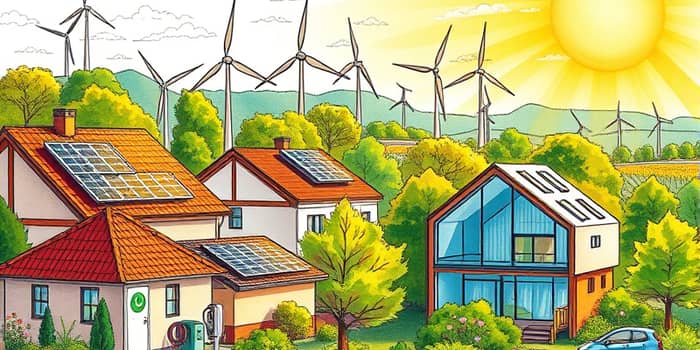In a world racing to combat climate change, access to capital for eco-conscious initiatives is more critical than ever. Eco-friendly loans offer a path to finance renewable energy installations, green home upgrades, and sustainable transport solutions, all while delivering significant environmental and economic benefits.
What Are Eco-Friendly (Green) Loans?
Green loans are specialized financing products where loans where the proceeds are exclusively used to support projects that generate clear environmental benefits such as renewable energy. Unlike green bonds traded in public markets, green loans are structured in the private lending sector, available to both individuals and businesses.
Sustainability-linked loans, on the other hand, tie their interest rates or terms to a borrower’s performance against pre-set environmental targets. While both products advance sustainable finance, green loans ensure direct funding for tangible green projects, from solar panel installations to water conservation systems.
Projects and Activities That Can Be Funded
Eco-friendly loans cover a broad spectrum of initiatives. Borrowers can tackle energy efficiency, embrace clean transportation, or invest in waste reduction. Below are some common project types:
- Renewable energy systems: solar panels, wind turbines, geothermal units
- Green buildings: energy-efficient retrofits, sustainable materials
- Clean transportation: electric vehicles, hybrid fleets, e-bikes
- Pollution prevention: waste recycling technology, water treatment
- Sustainable water management: rainwater harvesting, efficient irrigation
Real-world savings are compelling. A residential solar installation can yield $10,000–$70,000 in energy cost reductions over 25 years. Geothermal heat pumps may save homeowners around $1,500 annually, with payback periods ranging from 10 to 20 years.
Market Trends and Regulatory Context
The sustainable debt market has exploded in recent years. In 2024, total global issuance surpassed US$1.6 trillion, with assets under management in the sustainable space reaching US$3.2 trillion. Europe leads in regulatory oversight and volume, while growth in Asia-Pacific and EMEA offsets a steadier pace in North America.
Regulatory bodies are mandating greater transparency through climate disclosure rules, such as the EU’s Corporate Sustainability Reporting Directive and forthcoming SEC requirements in the United States. This heightened oversight drives lender and investor confidence, making green loans critical for meeting global sustainability targets.
Who Offers These Loans and How to Qualify
Eco-friendly loans are available through various channels:
- Commercial lenders: banks and credit unions with dedicated green loan programs
- Peer-to-peer platforms: direct project funding from individual investors
- Government initiatives: grants, rebates, and loan guarantees for eco-projects
For example, Clean Energy Credit Union provides up to 20-year loans for solar installations and six-year loans for electric vehicles, all with fixed rates and no prepayment penalties. Vermont’s VSECU offers low-rate financing for heat pumps, e-bikes, energy-efficient appliances, and EVs, with extended repayment options.
Eligibility depends on factors such as project scope, borrower credit, and demonstrated environmental impact. Prospective applicants should review lender criteria closely and assemble relevant documentation—project plans, cost estimates, and any required environmental assessments.
Benefits and Challenges
Eco-friendly loans deliver tangible returns:
- Environmental impact: reduced CO₂ emissions and resource conservation
- Economic savings: lower utility costs and maintenance expenses
- Increased property and business value
- Access to special terms and lower rates
- Support for corporate and national net-zero pledges
However, challenges remain. Upfront costs can be a barrier despite long-term gains. Borrowers must ensure installations are sized correctly and technology is suited to their properties. Navigating eligibility requirements and comparing offers takes time and research.
Practical Steps to Secure an Eco-Friendly Loan
- Identify your project’s goals and potential environmental benefits.
- Research lenders and compare green loan offerings.
- Obtain detailed cost estimates and energy savings projections.
- Gather financial documents: credit history, income verification, collateral details.
- Consult with professionals for independent financial and environmental advice.
- Submit a comprehensive loan application and follow up on additional requirements.
By following these steps, homeowners and businesses can streamline the funding process, minimize delays, and maximize their project’s environmental and economic outcomes.
Future Outlook
The momentum behind sustainable finance shows no signs of slowing. As governments tighten climate regulations and investors seek ESG-aligned opportunities, demand for green loans will continue to rise. Residential, commercial, and public-sector borrowers alike will leverage these products to drive decarbonization, making eco-friendly loans a cornerstone of global climate action.
By embracing green financing, you not only secure funding for your project but also join a broader movement toward a cleaner, more sustainable future. The time to act is now—invest in the planet and reap lasting rewards for generations to come.
References
- https://www.worldbank.org/en/news/feature/2021/10/04/what-you-need-to-know-about-green-loans
- https://online.hbs.edu/blog/post/types-of-sustainable-debt
- https://www.aspiration.com/resources/what-is-a-green-loan
- https://www.nordea.com/en/news/what-are-green-loans
- https://www.fibe.in/blogs/what-is-green-finance/
- https://www.tdsecurities.com/ca/en/sustainable-finance-outlook-2025
- https://www.british-business-bank.co.uk/business-guidance/guidance-articles/sustainability/green-loans-for-smaller-businesses
- https://www.acuitykp.com/blog/green-loans-sustainability-linked-loans/










